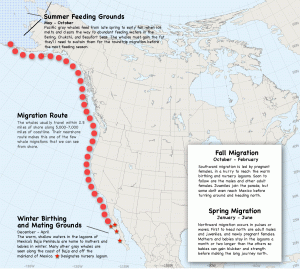
It’s the holiday season! In many places around the world that means it’s time to bundle up or travel somewhere close to the equator—somewhere warm. Many animals have that same mindset. The transition into the winter season can cue biological processes in animals, like migration and hibernation.
Organisms migrate for a variety of reasons like food availability, breeding, and a favorable climate. The arctic tern hold the record for longest migration, a whopping 12,000 miles one way. The second longest migration belongs to a whale. The gray whale. Once winter begins to roll around, pregnant females lead a migration down to the warm waters of Baja. The whales will remain there until the newborn calves are ready to make the long journey back north to the waters off Alaska, where they feed over summer.
 Other animals will hibernate—remain dormant—over the cold winter months when food is scarce and conditions are harsher. Characteristics of hibernation include a lower body temperature, a slow heart rate and breathing rate. A species of frog, the wood frog, takes hibernation to an extreme. It freezes. Completely. It’s heart stops beating, it stops breathing, ice crystals form in and around its body. Once they defrost, everything gets up and running again, until next winter. Bears are another example of hibernators, though their hibernation is much less extreme. Even (female) polar bears, who are adapted to some of the coldest weather will hibernate when pregnant and after birth until conditions are good enough for her and her cubs to emerge from their den.
Other animals will hibernate—remain dormant—over the cold winter months when food is scarce and conditions are harsher. Characteristics of hibernation include a lower body temperature, a slow heart rate and breathing rate. A species of frog, the wood frog, takes hibernation to an extreme. It freezes. Completely. It’s heart stops beating, it stops breathing, ice crystals form in and around its body. Once they defrost, everything gets up and running again, until next winter. Bears are another example of hibernators, though their hibernation is much less extreme. Even (female) polar bears, who are adapted to some of the coldest weather will hibernate when pregnant and after birth until conditions are good enough for her and her cubs to emerge from their den.

What do you choose to do this winter? Are you a bundle-er or a traveler?
Happy holidays!
To learn more:
https://www.nature.com/scitable/knowledge/library/animal-migration-13259533


